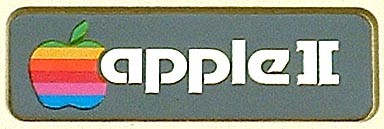|
Apple II
Forever(!?!)
The Apple II Back in the seventies, when the home computer revolution was just getting started, I dearly wanted an Apple II. The Apple was, arguably, the first real personal Even if you had the money, which most people didn't, a computer in the early days needed computer operators, punch card operators, programmers, checkers, flowcharters, and a host of others. There was nothing personal about them. The first home computers were little different. Early home computers, like that Altair, were programmed through panel switches, built from kits, and had very little capacity. They were designed around the new breed of microprocessors, like the 8008, and 8080. These processors were never meant to be used in computers; but were designed for use in automated products for the home, or for automating factory machines, cars, and appliances. In my mid twenties, I finally got myself an Apple, after having wanted one since my mid teens. I never did get myself a 2E, or any of the other earlier expandable 8 bit version of the Apple 2. My first was an Apple IIC, and for several years, I had finally found the machine that gave me everything I could want from a computer. This was my fourth computer (After having had a Vic -20, Adam, and C64), and the first with which I was completely satisfied. There had been nothing wrong with my previous computers, but all lacked the polish, and the completeness of the Apple. This computer had a pair of 5 1/4" floppies, a modem, joystick, and eventually, even a printer. The machine had a price of $1300 at the time; but I picked it up for around $500, used, which was a bargain, but was still quite a bit of money for those days.  What was great about the Apple, when compared to my previous
machines, was that it had become a standard, and there were
huge amounts of hardware and software available. The Apple
II was the computer of choice in the schools, and even
showed up in offices. So it was possible to actually get
some good business software and do some real work on this
machine. Apple ended up selling something like five
million of the II series machines, meaning that there was
one for every fifteen households, or thereabouts. It
also seemed like these machines would go on forever. Apple 2
Forever was even a popular slogan, started by the company
itself, which seemed to imply that generations in the
future, there would still be Apple 2 computers, perhaps on
Mars, or being used by colonies on planets orbiting other
stars. Like Rome, the eternal city, this would be the
eternal computer. Unlike the corporate edifice which
produced the other home computers on the market, the Apple
was produced by Steve and Woz, two guys whose faces you
could see, and who started making computers in their garage.
Well, we never did get to Mars, Steve and Woz were forced
out of their own company (though they did eventually
return), and the Apple 2 line ended in the early nineties,
to be upstaged by the Mac.
What was great about the Apple, when compared to my previous
machines, was that it had become a standard, and there were
huge amounts of hardware and software available. The Apple
II was the computer of choice in the schools, and even
showed up in offices. So it was possible to actually get
some good business software and do some real work on this
machine. Apple ended up selling something like five
million of the II series machines, meaning that there was
one for every fifteen households, or thereabouts. It
also seemed like these machines would go on forever. Apple 2
Forever was even a popular slogan, started by the company
itself, which seemed to imply that generations in the
future, there would still be Apple 2 computers, perhaps on
Mars, or being used by colonies on planets orbiting other
stars. Like Rome, the eternal city, this would be the
eternal computer. Unlike the corporate edifice which
produced the other home computers on the market, the Apple
was produced by Steve and Woz, two guys whose faces you
could see, and who started making computers in their garage.
Well, we never did get to Mars, Steve and Woz were forced
out of their own company (though they did eventually
return), and the Apple 2 line ended in the early nineties,
to be upstaged by the Mac. For a couple of years, my Apple 2C lived on a small desk in the back hallway of my apartment. This was a fairly secluded part of the apartment, and I recall whiling away many happy hours on this machine. Computer geek stereotypes aside, I spent most of my computer time, with the word processor component of Apple works, rather than playing games. The Apple 2C is the computer which started me off in word processing and addicted me to writing for pleasure. There was something wonderful about coming home at night and burning the midnight oil, and writing, playing games, or perhaps (in those pre internet days) using my modem to dial into one of the local BBS locations. I was in college, back in those days, and would often bring this computer to school, and sometimes even to work. I would even bring the little beast to the  docks, and
sometimes bring it on board my boat. When Apple introduced
the 2 GS, in 1986, I had to have one. It is difficult to
realize, these days, just how amazing the 2GS seemed back
then. It had great sound, great graphics, and was a 16 bit
machine which operated at what was considered to be a high
speed for the day. In addition to this, it was backward
compatible with my 2C, and I could share files between the
two. So I could have my more powerful 2GS at home, and have
my smaller, more portable integrated 2C as a second
computer, or a machine to take along. The GS had both a 5
14", and 3.5" drive, and even had a hard drive. This was a 1
GB external drive, a huge drive for the day. The drive was
connected through an SCSI card.
docks, and
sometimes bring it on board my boat. When Apple introduced
the 2 GS, in 1986, I had to have one. It is difficult to
realize, these days, just how amazing the 2GS seemed back
then. It had great sound, great graphics, and was a 16 bit
machine which operated at what was considered to be a high
speed for the day. In addition to this, it was backward
compatible with my 2C, and I could share files between the
two. So I could have my more powerful 2GS at home, and have
my smaller, more portable integrated 2C as a second
computer, or a machine to take along. The GS had both a 5
14", and 3.5" drive, and even had a hard drive. This was a 1
GB external drive, a huge drive for the day. The drive was
connected through an SCSI card. Time stands still for no one, and it seems particularly uncharitable to computers. After a couple of years, the IBM PC, and clones, were clearly starting to dominate the market. In addition to this, Apple was concentrating all of its energies on its Macintosh, in violation of the promises it had been continually making to the Apple 2 faithful. Software developers, too, seemed to be abandoning the Apple 2, for the more more powerful, and less archaic PC class machines, and Macs. Though it would be several years before I shelved the trusty Apples, I eventually bought a Leading Edge, Model D. This was a PC class machine, featuring an 8086 processor, and dual 5 1/4" drives holding 1.44 MB. It had 640K of ram, and would eventually get a 20MB hard card. Even so, for years, I still used the old Apples, playing games, accessing and adding to my writings, with Apple works, and even doing the occasional bit of school work; but eventually their days ran out. A few years latter, I picked up a Windows 3.1 machine, and retired the old Apples, as well as the Leading Edge. 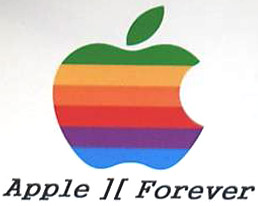 Apple is having a hard time getting, and keeping, market
share, these days. The Mac is a pretty good machine, yet Apple never
seems able to grab more than maybe 8% of the computer
market. Many blame this on IBM, and the pervasiveness of the
PC; but I think much of the blame belongs with apple. The
Mac is proprietary and closed, and it is expensive. For
the first ten years of their existence, Apple owned the home
computer market. They then made some pretty serious
marketing, and public relations errors, from which I don't
think they will ever recover. The biggest mistake that they
made, was to dump the Apple 2, with no warning, and leave the largest and
most established user base in the world, up the creek. What made this
even worse, was that it happened after years of constant
reassurance that this was the one thing that Apple would
never do. Needless to say, this alienated a huge segment of
the home computer market. Suddenly, the Apple left a bitter
taste in many mouths, and the popular slogan "Apple II
Forever" had a hollow, mocking sound. Many never forgave,
and most did not forget. Apple is having a hard time getting, and keeping, market
share, these days. The Mac is a pretty good machine, yet Apple never
seems able to grab more than maybe 8% of the computer
market. Many blame this on IBM, and the pervasiveness of the
PC; but I think much of the blame belongs with apple. The
Mac is proprietary and closed, and it is expensive. For
the first ten years of their existence, Apple owned the home
computer market. They then made some pretty serious
marketing, and public relations errors, from which I don't
think they will ever recover. The biggest mistake that they
made, was to dump the Apple 2, with no warning, and leave the largest and
most established user base in the world, up the creek. What made this
even worse, was that it happened after years of constant
reassurance that this was the one thing that Apple would
never do. Needless to say, this alienated a huge segment of
the home computer market. Suddenly, the Apple left a bitter
taste in many mouths, and the popular slogan "Apple II
Forever" had a hollow, mocking sound. Many never forgave,
and most did not forget. Apple was always very good at the technical side of producing computers, and excelled at ergonomics, they produced some really great products; but often their business decisions seemed designed to make their users buy their very good products, despite the often very bad company that produced them. In my own case, one of the things that had kept me from buying an Apple, for so many years, was the cost. Apple always saw their machines are premium products, for an upscale market, and priced them accordingly. This would hurt them, when others started cloning their products, and would hurt them badly, when PC manufactures began to compete heavily, and price according to what things cost to make, rather than gouging the market. Apple continues with this policy today, pricing their machines higher, than what the cost of production would justify. Still, people pay it; but only a small fraction of the market is so willing. With the 2 GS, though, Apple really seemed to go out of their way to treat their customers badly, and to guarantee that many would never buy another Apple product again. The base cost of the GS was $999, back in 1986, a lot of money at the time. With monitor, this went up to $1495. Throw in a couple of floppy drives, a printer, some decent speakers, a bit of software, and maybe a modem, and possibly even a hard drive, and you are talking a $5000 system. People bought these systems in droves, because, for years, 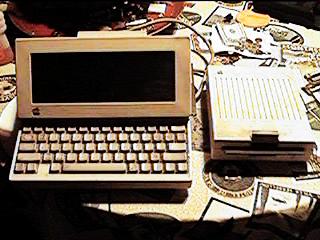 the Apple faithful had been waiting to see what the company
would do to evolve the venerable line, the grand old man of
the home computing world. They were also holding back, to
see if Apple was going to displace the old Apple 2, with the
new Macintosh. With Apple's promises, and the introduction
of the new GS, all fears were put to rest, and people
bought. Over a million GS machines were sold, accounting for
something like a quarter of all Apple 2 machines produced.
the Apple faithful had been waiting to see what the company
would do to evolve the venerable line, the grand old man of
the home computing world. They were also holding back, to
see if Apple was going to displace the old Apple 2, with the
new Macintosh. With Apple's promises, and the introduction
of the new GS, all fears were put to rest, and people
bought. Over a million GS machines were sold, accounting for
something like a quarter of all Apple 2 machines produced.
This very expensive system brought in huge amounts of money, and made Apple massive profits. These profits were immediately rolled into development of the Mac, as was most of Apple's advertising budget, and much of it's support structure. Within a few years of the introduction of the GS, it had been vastly overtaken by the PC, and by Apple's own Mac. Having stood still for five years, with virtually no development, the 1986 technology of the GS could not compete with the 1992 technology of it's PC and Mac competition, and was discontinued. The huge user base of the Apple 2 watched with dismay, and then with fury, as their beautiful (and very expensive) machines were allowed to languish and then die. Many felt betrayed, believing that they had been suckered into buying into the last gasp of the Apple 2 system, only so that they could be used to finance development of the Mac. From that time on, Apple ceased to be the major player in the home computing market. a market that it had largely created, and which it had dominated for a decade. The Apple IIC
The original Apple 2 had eight 50 pin slots near the rear of the main board. These were numbered from 0 to 7 from left to right. Though the slots are of identical design, and capacity, convention eventually determined the following card slot assignment: Slot 0 16kB Language card Slot 1 Printer port Slot 2 Modem port Slot 3 80 Column card Slot 4 Mouse port Slot 5 Optional (RAM card, Z80 Softcard) Slot 6 Disk Controller card Slot 7 Optional Cards installed outside of these conventions can not be guaranteed to work properly, since most software was written to assume these locations. The capability of the original Apple 2 to accept expansion cards was a real advance, and greatly helped to extend the life and power of these computers, but has been rendered somewhat moot, for the casual user, by advancing technology. For the 2C, the entire disk controller, which had previously been a card fitting in slot 6, was placed on a single chip, of the system board. In similar fashion, integrated versions of the other common expansion cards were included, in miniaturized form, on the main board. Even without expansion slots, the 2C was as capable as any fully expanded Apple 2 desktop. The onboard card emulators were mapped to card slots, to retain software capability. From a software perspective, the Apple 2C had the following expansion cards: Slot 0 16kB Language card (32K in 2C) Slot 1 Printer port Slot 2 Modem port Slot 3 80 Column card Slot 4 64K RAM expansion (ROM 3) Slot 5 Nothing Slot 6 Disk Controller card (virtual in 2C) Slot 7 Mouse port (ROM 3) In addition to the integration of the expansion slots, the floppy drive was also integrated into the machine. On the original machine, there is a 5 1/4" drive 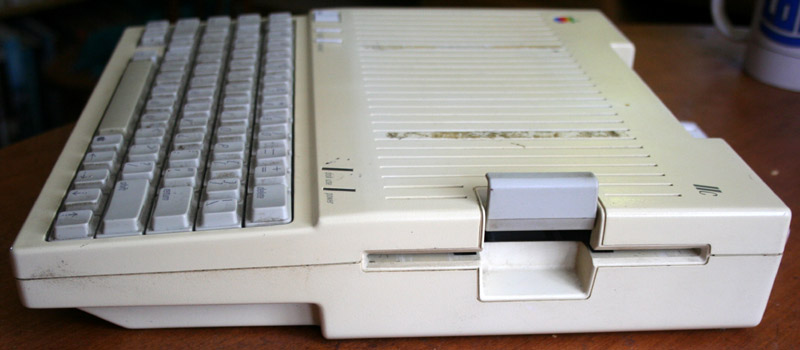 mounted on the right hand side of the case. This drive holds
140K, which was considered to be a considerable capacity in
its day. It was necessary to have a system floppy in the
drive, when booting the computer, since these had no hard
drives. Most users had multiple system disks, and creating
new ones was fairly easy. Unlike today's huge operating
systems, the ProDOS system that ran the Apple 2C was small
enough to take up only a small portion of a 140K floppy.
Many applications were sold on bootable discs. In practice,
for those who could afford what at that time was a rather
expensive option, the ideal was to have the system or
program disk in the built in drive, with a formatted data
disk in an external drive. This saved the user the trouble
of having to constantly swap discs.
mounted on the right hand side of the case. This drive holds
140K, which was considered to be a considerable capacity in
its day. It was necessary to have a system floppy in the
drive, when booting the computer, since these had no hard
drives. Most users had multiple system disks, and creating
new ones was fairly easy. Unlike today's huge operating
systems, the ProDOS system that ran the Apple 2C was small
enough to take up only a small portion of a 140K floppy.
Many applications were sold on bootable discs. In practice,
for those who could afford what at that time was a rather
expensive option, the ideal was to have the system or
program disk in the built in drive, with a formatted data
disk in an external drive. This saved the user the trouble
of having to constantly swap discs. 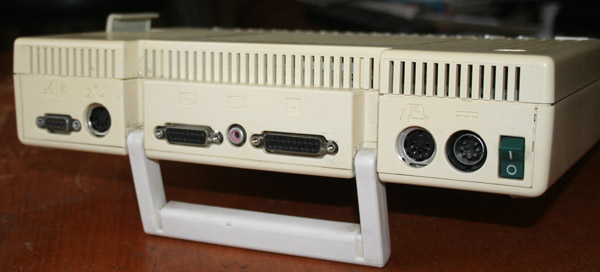 A connector for an extra drive is on the back of the case,
as well as connectors for a modem, printer, joystick,
composite monitor, a connector for a high res Apple monitor,
and the connector for the power supply. This is also where
the power switch is located. In order to save space, in the
small case, and head off cooling problems, the power supply
itself was in a large brick, which sat outside the case. It
was on a long enough cord, that it could remain on the
floor, even with the computer at desktop level. Though this
was a compact, integrated machine, Apple never really meant
for the design to be portable, except in the sense that it
could easily be transported from room to room, or office to
home. The machine had a carrying handle at the back, which
was designed to be folded down, to act as a sort of a stand
to angle the keyboard for easier typing. A connector for an extra drive is on the back of the case,
as well as connectors for a modem, printer, joystick,
composite monitor, a connector for a high res Apple monitor,
and the connector for the power supply. This is also where
the power switch is located. In order to save space, in the
small case, and head off cooling problems, the power supply
itself was in a large brick, which sat outside the case. It
was on a long enough cord, that it could remain on the
floor, even with the computer at desktop level. Though this
was a compact, integrated machine, Apple never really meant
for the design to be portable, except in the sense that it
could easily be transported from room to room, or office to
home. The machine had a carrying handle at the back, which
was designed to be folded down, to act as a sort of a stand
to angle the keyboard for easier typing. This particular example of the 2C has ROM 3. This latter revision had a number of improvements over the original. It was possible to upgrade this machine to over 1MB of ram. The machine would also take the new (for the time) 3.5" Apple floppy drive, which could hold 800K, compared to the 140K of the standard 5 1/4" drive. Removed from the machine, were the last vestiges of any presumption of portability. Previous versions had featured a membrane under the keys on the keyboard, to protect against dirt, spills, sand, or whatever, in possible outdoor environments. This membrane, along with ROM support for the never developed Appletalk networking protocol for the Apple 2, was removed. Appearance was changed slightly, by using gray plastic for the drive lock, handle, and keys, instead of the previous beige. The color scheme and ergonomic design of the new Apples were quite a big deal, at the time. Apple made a big deal about the Snow White, and Platinum color 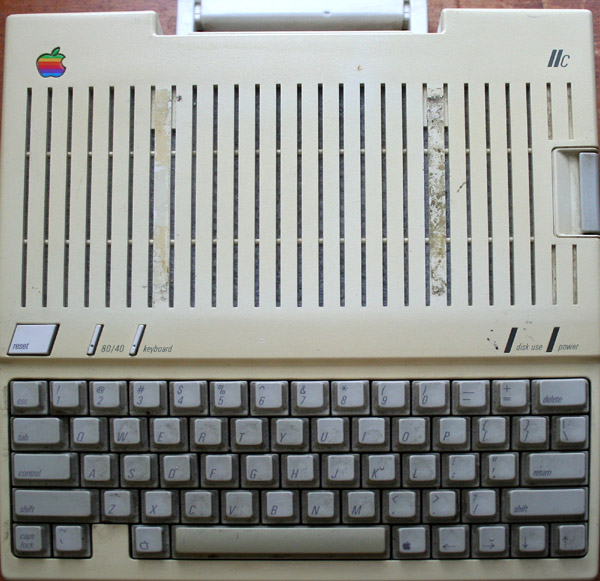 schemes, which continued on with the 2GS, and 2C+, until the
line was ended, and was even carried on, to a degree, with
the Macintosh. Previous entries in the Apple 2 line, looked
a bit like some kind of typewriter on hormones. The newly
designed computers looked like computers. The design scheme
encompassed processing units, monitors, keyboards, mice, and
even printers. It really did seem like Apple meant to carry
on the 2 series forever. The case has yellowed a bit, in the
last twenty years; but is still fairly good looking.
Interestingly, the gray plastic accents and keyboard have
retained their original color.
schemes, which continued on with the 2GS, and 2C+, until the
line was ended, and was even carried on, to a degree, with
the Macintosh. Previous entries in the Apple 2 line, looked
a bit like some kind of typewriter on hormones. The newly
designed computers looked like computers. The design scheme
encompassed processing units, monitors, keyboards, mice, and
even printers. It really did seem like Apple meant to carry
on the 2 series forever. The case has yellowed a bit, in the
last twenty years; but is still fairly good looking.
Interestingly, the gray plastic accents and keyboard have
retained their original color. Part of the ergonomic concept was the inclusion of a keyboard map for the Dvorak keyboard. This could be toggled on, by use of the keyboard button, above the keyboard itself. next to this button, were the reset switch, and a button to toggle between 40 and 80 column. To the right, above the keyboard, are lights for power and disk use. All in all, the presentation of the computer is great, elegant, understated, and sophisticated. just the kind of image Apple was trying to project, with IBM snapping at its heels. So well regarded was the design, that it was shown, briefly, in the movies 2010, and A View To A Kill. The two soiled strips, visible in the photo to the right, are from a set of adhesive strips I had put in place to try and hold the LCD display in place. Though this was not a portable computer, in the sense of today's laptops, there were attempts made, by Apple, and others, to make something of the sort, of this machine. Third party developers introduced battery packs, to try and make the 2C a truly portable computer. Some succeeded to a certain extent, but these were heavy, expensive, and limited. Overall, though, the time was just not right, and the technology not quite ready. In a decade, laptops would be all the rage. In anticipation of this, Apple introduced its Apple Flat Panel Display. This was a high resolution (80- column) display which sat on top of the machine. 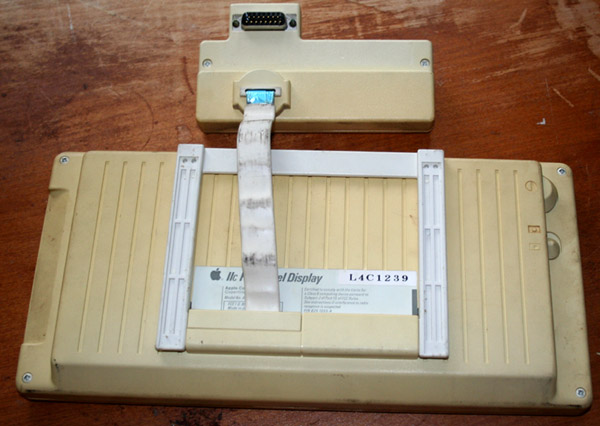 The Apple Flat Panel Display was expensive, and offered only
a 1 bit, black and white image. It also had an odd aspect
ratio which was fine for text, but distorted any kind of
graphics. There is no backlight, and really not much in the
way of quality graphics possible. With a one bit display,
the gray scale does not exist. This was another piece of
Apple technology which was just a bit ahead of the
engineering of the time. Though the display was designed to
sit on top of the machine, it was not designed to mount
permanently. It also had a very large and somewhat
cumbersome connector, which probably housed some of the
display driving hardware. This connector is linked to the
actual display unit by a somewhat fragile flat parallel
cable. There are only two adjustments for the picture. One
reverses the display to show black text on a white
background, and the other is a sort of a contrast control. The Apple Flat Panel Display was expensive, and offered only
a 1 bit, black and white image. It also had an odd aspect
ratio which was fine for text, but distorted any kind of
graphics. There is no backlight, and really not much in the
way of quality graphics possible. With a one bit display,
the gray scale does not exist. This was another piece of
Apple technology which was just a bit ahead of the
engineering of the time. Though the display was designed to
sit on top of the machine, it was not designed to mount
permanently. It also had a very large and somewhat
cumbersome connector, which probably housed some of the
display driving hardware. This connector is linked to the
actual display unit by a somewhat fragile flat parallel
cable. There are only two adjustments for the picture. One
reverses the display to show black text on a white
background, and the other is a sort of a contrast control.The various disadvantages of the LCD display make it pretty unsuitable for any sort of true portability, though it does have the great advantage of being powered by the computer itself, and needs no outside power source. Thus a 2C, with a battery pack, will need no power source for the LCD monitor. Even so, with its delicate connection cable, and no permanent mounting to the computer itself, the unit is just too delicate for field use. In addition, its lack of color, contrast, and normal aspect ratio, make it inferior to a standard monitor for day to day use. I am not knocking it, for its day, this was a cutting edge piece of technology. I have one myself. What all of these disadvantages add up to, is a display that was not very popular and sold few units. This is quite a rare piece of gear, and very few are in existence. Many people are unaware that Apple ever even made an LCD display for this machine. The green screen monochrome, or Apple Color Monitor were far more common, and most purchasers probably just used the RF converter and hooked their 2C up to a standard television. The lack of true portability was not really a failure, as the machine was never designed for such a role. As a computer version of the home portable television, the 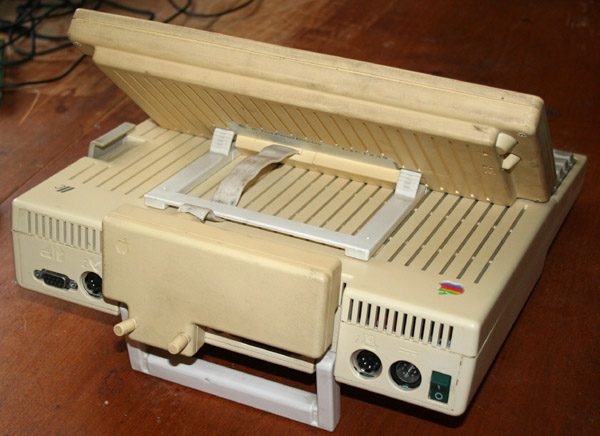 2C was ideal. This was to be a user friendly appliance
like computer - the ultimate expression of the user friendly
concept that had been responsible for the success of Apple
from its beginnings. The LCD display was simply an example
of Apple pushing the envelope. Had the technology been up to
it, Apple may very well have ushered in the laptop computer.
2C was ideal. This was to be a user friendly appliance
like computer - the ultimate expression of the user friendly
concept that had been responsible for the success of Apple
from its beginnings. The LCD display was simply an example
of Apple pushing the envelope. Had the technology been up to
it, Apple may very well have ushered in the laptop computer.
The Apple II GS
Before the advent of the IBM, there was a vast array of different computers and operating systems. These were brought together somewhat by the introduction of C/PM, which became so popular that Apple introduced a coprocessor card that would run it. Many of the original machines like the old Altair, were still being sold when the first Apple came out. There have been several huge cullings of the computer market since then, including one shortly after the introduction of the IBM PC, which basically wiped out every computer manufacturer except Apple and IBM. The amazing Apple survived this melee only to be squashed by its' own company a few years later. The final glory of this computer was the model which I own, the II GS. This is a sixteen bit computer with built in sound and high quality (for the time) graphics, thus the model designation GS. At the time this computer was introduced, the old 8 bit Apple II was beginning to look a bit dated compared to the new IBM. Even Apples' own Mac was eclipsing the veteran computer except among some die hards. The Mac had been designed by Apple as a business machine, while the old Apple II was to be aimed at the home market. Apple came up with this strategy because the II market was so huge that it would have been folly to abandon it; but they had to come out with a machine which used updated technology in order to stay competitive. When this machine came out, the contemporary PC computer was the 386, and there was still wide spread use of the 286. The only real competitor for the GS was the Amiga, which would also be abandoned by its' parent company. Windows was out, at this time, but it had by no means become universal. I remember seeing an early windows operating system running on a machine at school, and thinking "what's the point". Had Apple gotten into the game with this machine a bit earlier the story might have been different, but with the introduction of the 32 bit 386 CPU, IBM/Intel had a clear advantage in power. The tremendous lead of the II GS in graphics and sound would soon be addressed by PC after market card manufacturers, and by the GUI Windows. The Apple II GS operating system was a true graphics run system, but widespread use of Windows in the PC eliminated this advantage. Interestingly, the What made Apple decide to drop the II series is hard to say. they clearly had planned on keeping it around for a while, as can be seen by the development of the GS, and by the work put into the new GS/OS operating system. The GS/OS is a full 16 bit operating system, as opposed to ProDOS, and earlier Apple 2 systems. This is more than just a DOS, and includes a HUI, the ability to use mini-drivers, and a toolkit and accessories. It seemed to be, essentially, a port of the Macintosh OS, for the II GS. This system was capable of reading Mac, as well as DOS formatting, along with some others, and even included a programming tool kit. I use version 6.01, for which Apple recommends at least 2 MB of RAM, and had to break my drive up into a number of different partitions, due to the drive size limits of the operating system. I will need to get a bit more involved, and relearn the system. In addition, I will have to catch up on the latest developments. Though Apple abandoned this series, there is a pretty dedicated following, and there is still work being done by outside developers. The machine I own has the latest bios, and an scsi card, along with a large (for the Apple) hard drive and both 3 1/2 and 5 1/4 inch drives. I have 4mb of RAM in this machine which is a large amount for an Apple. Extra memory is on a memory expansion card, using chips, rather than today's more common memory modules. The maximum amount for this machine was 8 MB. Recall that this is before Windows 95, in a day when a PC could only hold 1 MB, and could only directly address 640K. This was just one of the many ways in which the last of the Apples was far more advanced than the PC class machines which were about to take over the home computing market. Back in those days, for most people, floppy drives were the ultimate storage. Apple had introduced a hard drive as early as 1981. The $3500 profiler, held only 5mb, and was really only an option for a business. $3500 in those days was something like $10000 in today's money. So for most people it was the floppy. This is not as big a handicap as it might seem. A 140K floppy was capable of holding an entire library of programs back then. Many programs only used a couple of K's, while even a large program, like a spreadsheet or word processor, might only use a few dozen K, Most users had libraries of floppies, holding operating systems, programs, and data. Generally, program discs would be bootable, and would be placed in the boot floppy drive. A second drive would hold the user's data disc, where work would be saved. The average JPEG image of today, is larger than most payroll and business programs of the eighties. When the new 800K, 3.5" drives came out, Apple users were delighted. Here was all the space you would ever want, for programs, data, or anything else. In those pre network, and mostly pre hard drive days, the floppy was your archive, the place you saved your work, your system disk, and even your method of communicating with other computers - via the sneakernet**. So Soon after I got my II GS, I had to have a hard drive. Apple's own versions were expensive, and used the somewhat (for the time) proprietary SCSI drive, introduced for the Macintosh. They also, frankly, were not very big. Most seemed to be around 200 - 300 MB. I eventually found an industrial style drive for sale, which was housed in an external SCSI case. This was a 1 gb drive, huge for its day. It was designed to be used in factories, for automated machines, and was built like a tank. It had its own internal power supply, and an SCSI 2 connector, which was what my Apple 2 GS card required. This was a wonderful drive, the quality The hard drive made it possible for me to dispense with boxes, drawers, and shelves full of floppies, and put everything right in one place. Of course, with such small programs, and so many of them, it is as easy to get lost in the drive, as it was to try and find the right floppy, when wanting to run a program, or searching for some work done. The floppies are now there only for archiving, or for the dreaded instance of this drive crashing. In contrast to many of the PC compatibles out there, the Apple is wonderfully crafted inside and out. There are no cables or wires dangling around or tangled inside; beautiful. There is a power supply, a motherboard, and a single wire harness. The eight expansion slots are visible, unobstructed, at the rear of the case. This kind of clean design has always been a sort of a hallmark of Apple computers. For most users, the slots would never be used. Like the Apple 2C, most of the need for the card expansion of earlier models, had been taken care of. using on board chipsets. The machine is opened by depressing a set of latches, on either side of the rear of the case. The top cover is then angled off, like a clamshell. This kind of screw less design was latter copied by many PC manufactures. The case of the 2 GS is very small, giving the machine a very compact footprint. This small footprint also means that there is no room for any drives, and that the user will need, at the Much of the new GS had the look and feel of the Macintosh, which probably should have been a warning to prospective buyers. The new 3.5" 800K drives were the same as were being used by the Mac. The systems used the same RGB monitors, and even the same new ADB keyboard and mouse. The Apple GS/OS had very much the look of the Macintosh operating system. In point of fact, the Apple GS seemed to be the better of the two computers, despite the power, and newer design of the Mac processor. The GS, it seemed, could do anything the Mac could do, plus run the huge library of Apple 2 software, and do it all with what were far better sound and graphics capabilities than those of the Mac, or of any PC class machine. On top of this, the Apple 2 GS cost less than the Mac. The GS team, it seems, did their job far too well. The machine would be a serious contender for the fledgling Mac, upon which Apple was settling most of its hopes for the future. As a sort of a tag along machine, or perhaps a home alternative, for the legions of Apple 2 faithful, it seemed like a good idea to update the machine a bit; but once it became an obvious threat to the Mac, its days were numbered. The GS was capable, with suitable programming, of displaying over 4000 colors. This was in addition to its sixteen bit, 32 voice, wave table, stereo sound, provided by an Ensoniq sound chip. The Ensoniq was being used in many synthesizers, and electronic instruments of the day, to give musicians and studios the capability of adding musical effects which sounded like real instruments, to recordings. The GS was, along with the Amiga, one of the very few true multimedia machines available at the time. I recall seeing one demonstrated, soon after introduction of the model, at a local Apple computer store. The machine was playing a jazz composition, and on the screen, an animation showed the musicians playing their instruments in time with the music. What made this all the more striking , was the fact that this was not an actual music recording, being played back. It was a midi file, being rendered by the machine's wave table sound chip. This was a pretty impressive display, and left me longing for a GS, to compliment the little Apple 2C I already had. Hooking the machine up is not difficult, and requires little more than common sense, and a bit of concentration from the user. The back panel of the GS is The machine has an imagwriter II, and a 2400 baud (!!) modem. I am attempting to figure out how to put the old Apple on my network. It is reputed to have some built in networking features, but since its abandonment, it is very difficult to get parts or information on it. The built in networking is the old Appletalk, which is proprietary, and kind of limited. I am hoping that one of the current crop of hobbyist/developers, for the Apple 2 has developed a regular Ethernet card for the machine. I suppose I can always connect it via it's serial port. I will just have to see. If I ever do manage to network the machine its' network name will be "Annie". For those who are interested, the final operating system for the GS (version 6) is available for download, free, from Apple's website at: http://www.info.apple.com/support/oldersoftwarelist.html For those who do not have access to an old working Apple 2, and do not wish to have to hunt around and try to resurrect old hardware, there are a number of Apple 2 emulators around, and a surprisingly large number of user groups, sites, and software archives. It might be worth visiting some of these sites, and maybe given g an emulator a try, just to get a taste of what the early days of the home computer revolution were like. Apple Links
**The Sneakernet was an early method of sharing data, or programs, with computers at various locations. The way that it worked was, you would save the program or data onto a floppy disc. You would then put on your sneakers, and run out to wherever the other computer might be, and put the floppy into that other computer's drive. For two way communication, you would wait for the other computer to write to your disk. You would then run back, and read the disc onto your computer. The process was repeated as needed. handshaking was optional with this protocol. The two main disadvantages of the Sneakernet was that it was quite slow, and could be very tiring, depending upon the distance between the two computers (and how many stairs). Sneakernet was also affected by the weather, and could become even slower when it rained, or on very hot days. For those who lived in jungles or thickly forested areas, it brought a whole new meaning to the term "Hacker". |
